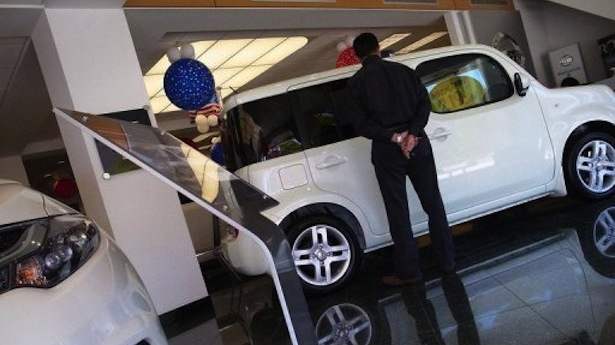Can flywheel technology drive out the battery from car hybrids?
Tuesday, January 28, 2014 13:09 EST

Consider the hybrid car. Halfway between the traditional motor and the fully electric Nissan Leaf or the Volkswagen e-Up!, they’re a nod to green motoring. While retaining a conventional diesel engine, they can harvest kinetic energy from the car’s braking motion and use that to power an additional electric motor.
But batteries are energy-intensive to manufacture, and the weight of a battery pack can add more than 50kg to a vehicle’s mass, which means increased fuel usage – though hybrids are still get more miles per gallon than the conventional versions of the same models.
Then there’s the matter of fuel efficiency – you’re going from kinetic to electrical to chemical (battery) energy, and back again, every time you use the system. The kinetic energy that would otherwise be lost as heat during braking is converted to electricity by a generator, which charges the battery, and is later converted back to kinetic energy.
Conversion losses are inevitable. And battery disposal poses its own environmental problems.
Batteries aren’t the only way to store kinetic energy, though. Hybrid cars can be made with flywheels instead of batteries. In these “flybrids”, the kinetic energy recovered during braking spins a flywheel. The recovered kinetic energy is stored in the spinning wheel, to be released upon acceleration. The amount of energy a flywheel stores comes down to its mass and the speed at which it rotates; prototypes have provided an 80bhp boost.
Compared with batteries, flywheels offer the prospect of improved fuel efficiency: energy remains in a mechanical form, rather than morphing through mechanical to electrical to chemical, so conversion losses are reduced. Flywheels are light(ish), typically coming in at 6-8kg. (To store up to 60 kilowatts of power despite their low mass, they spin at centrifuge-like speeds of up to 60,000rpm.) And they don’t present so many tricky issues when it comes to disposal.
In 2010, Porsche put a flywheel into its 911 GT3 RS Hybrid. A year later, Jaguar showcased its prototype flywheel hybrid XF holding the promise of a 20% improvement in fuel efficiency. Then in 2012, Audi Sport’s flywheel hybrid, the R18 e-tron quattro became the first hybrid car to win the legendary Le Mans 24-hour endurance race. In 2013, Volvo announced that its flywheel hybrid prototype could offer a 25% improvement in fuel economy.
Great. So when will we be able to drive one?
Well, if you’re a bus driver, you already can. Buses in London (and soon, Northern Ireland) are being used to try out the tech. But you can’t buy a flybrid road car yet.
Jaguar has halted its flywheel research. The decision was taken, Jaguar told me, because production possibilities were limited by “packaging issues and cost”. According to Flybrid Automotive, the UK company that devised its flywheel, Jaguar believes such a car would only be cost-effective if at least 60,000 a year were sold, and at the moment the infrastructure isn’t available to make that many flywheel drives.
Porsche has decided that the flywheel system isn’t “energy dense” enough for a passenger car. Volvo told me its flywheel hybrid research is in the advanced engineering phase – it described flybrids as an interesting possibility, but wouldn’t be drawn on a delivery date.
Does that mean that the early promise of the flywheel has … well, flown?
Maybe not. Earlier this month, a manufacturer called Torotrak bought Flybrid Automotive, and announced that within five years we could be buying flybrids for the road. “Mechanical flywheels have a long life, with good robustness against vibration, temperature and charge/discharge cycles,” Tobias Knichel of Flybrid tells me. “Unlike batteries, you can charge [a flywheel] up and slow it down almost as often as you want. You don’t have a degradation of performance over life.”
Flybrids may also be comparatively cheap to buy. If a manufacturer can be persuaded to make flywheel components in high volume, car price could be about one third of a battery hybrid.
So when does Knichel think we’ll see them on sale? “I’d estimate that we’ll see road cars shortly before 2020; 2018 or 2019.”
Sounds promising. So could flybrids compete with battery hybrids? Rob Thring of Loughborough University’s department of aeronautical and automotive engineering wonders if that’s a fair question. “Flywheels are a good way of storing energy. But as for comparing them to batteries – it’s like comparing petrol and diesel. Both have merit,” he says. “Flywheels’ have a lower energy density compared to batteries, but their power density is higher.”
Meaning flywheels can release stored energy far more quickly than batteries. So despite the fact that they can’t store as much energy for the same weight, they might actually be great for city-centre driving, characterised by short distances and endless stop-starts.
On the other hand, that lower energy density means a flywheel won’t get you to France – you’ll need to use the main engine most of the time. “You’d never create a flybrid that could drive with the engine switched off for, say, 50 miles,” Knichel says.
So will the remainder of the decade see a battle of the hybrids, with flywheels fighting it out with batteries? Doubtful. Batteries remain problematic in many ways, but battery innovation continues: it may even be that vehicle bodywork could be adapted to store energy.
Toyota, makers of the flagship hybrid, Prius, has no plans to develop flybrids. “We looked at all sorts back in the 1960s and 70s, and decided to go with battery [hybrid] road cars, and capacitors for racing.”
Toyota’s Richard Seymour told me: “We think that batteries are the best solution in terms of economy and emissions. And the majority of the components within our batteries are recyclable.”
The solution may be to incorporate both forms of storage into your future hybrid – a battery for the long drives, and a flywheel for the short stuff.
guardian.co.uk © Guardian News and Media 2014